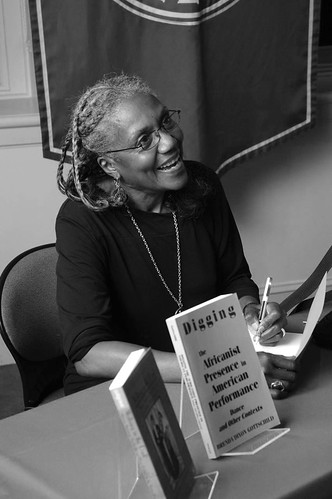
The troubled history of African-American ballerinas in Philadelphia and the subsequent founding of Philadanco is captured in professor Brenda Dixon-Gottschild’s recently published book, “Joan Myers Brown & the Audacious Hope of the Black Ballerina.”
“The Talented Tenth” describes the likelihood of one-in-10 black men becoming world leaders, through education, publishing literature and encouraging social change. African-American sociologist and civil rights activist W.E.B. Du Bois coined this term in 1903 after realizing that leadership could arise from many levels and that grass-root efforts were important to social change.
Dr. Brenda Dixon-Gottschild, professor emerita of dance studies, refers to “The Talented Tenth” as the beginning of sociology, and very relevant to society’s perspective on the place of dance in society.
“African-American dance reflects the highly-charged social and political measure of society, and who we are in the world,” Dixon-Gottschild said.
She has performed with her husband, choreographer and 1992 recipient of the Pew Center for Heritage Arts & Culture grant, Hellmut Gottschild, in a form of somatic and research-based collaboration, for which they coined the phrase, “movement theater discourse.”
Throughout Dixon-Gottschild’s work as a cultural scholar and researcher, she has used performance – specifically dance – as a measure and paradigm of society.
“In my professional life, I have journeyed from a career as artist-performer to writer-scholar, from practitioner to observer and, lately, a combination of both,” Dixon-Gottschild wrote on her website BrendaGottschild.com. “The two developments are driven by the same passion for the performing arts and my belief in performance as a highly charged, sociopolitical phenomenon.”
“Throughout history, African Americans have reveled for free expression in the midst of oppression,” Dixon-Gottschild said. “We have seen throughout America how fundamental dance is to free expression in the African-American community.”
Dixon-Gottschild is the author of several books: “History of Dance in Art and Education,” “Waltzing in the Dark: African American Vaudeville,” “The Black Dancing Body,” “Digging: the Africanist Presence in American Performance” and her latest book “Joan Myers Brown & the Audacious Hope of the Black Ballerina,” published in December 2011. Dixon-Gottschild said her literature discusses how dance can act as a means of free and unapologetic expression in the African-American community.
Dixon-Gottschild’s latest book is about Joan Myers Brown, the visionary founder and artistic director of Philadanco.
Dixon-Gottschild was awarded a 2011 production grant from the Pew Center for Arts and Heritage through Dance Advance to complete her book on Brown’s legacy.
The title references President Barack Obama’s “Dreams of My Father,” in which Obama references a sermon preaching hope for a better day.
“It resonated with me that one could be a ballerina as an African-American, even when someone said you couldn’t,” Dixon-Gottschild said.
Her book on Joan Myers leverages an investigation of the interface between performance, cultural formation, and race politics as evidence by the development of a dance community in black Philadelphia, and its influence beyond community and regional borders to national and international distinction.
Philadanco – also known as the Philadelphia Dance Company – is an internationally-renowned dance troupe founded in 1970 after the Civil Rights Movement. Myers founded the troupe to provide opportunities for black dancers, who were systematically denied entrance in many local dance schools.
“Dance allowed African-Americans to look at their history from a different perspective,” Dixon-Gottschild said.
More than 40 years after the dance company’s founding, it is recognized across the nation and around the world. According to the company’s website, “Philadanco is celebrated for its innovation, creativity and preservation of predominately African-American traditions in dance. Philadanco has a legacy of breaking barriers and building bridges across cultural divides.”
Today, Philadanco’s home-base is in West Philadelphia. The company provides one of the country’s most innovative and successful dance training programs.
Brown was honored as one of the Dance Women Living Legends in tribute to five African-American pioneer women who founded distinguished modern dance companies with deep roots in black communities around the country. She was also honored by the Kennedy Center for African-American Choreography.
“The beauty, energy and power as a kind of struggle of the black dancer demonstrate that we do not live in a post racist society,” Dixon-Gottschild said.
Priscilla Ward can be reached at priscilla.ward@temple.edu.


Be the first to comment